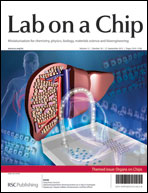Liver-cell patterning Lab Chip: mimicking the morphology of liver lobule tissue†
Abstract
A lobule-mimetic cell-patterning technique for on-chip reconstruction of centimetre-scale liver tissue of heterogeneous hepatic and endothelial cells via an enhanced field-induced dielectrophoresis (DEP) trap is demonstrated and reported. By mimicking the basic morphology of liver tissue, the classic hepatic lobule, the lobule-mimetic-stellate-electrodes array was designed for cell patterning. Through DEP manipulation, well-defined and enhanced spatial electric field gradients were created for in-parallel manipulation of massive individual cells. With this liver-cell patterning labchip design, the original randomly distributed hepatic and endothelial cells inside the microfluidic chamber can be manipulated separately and aligned into the desired pattern that mimicks the morphology of liver lobule tissue. Experimental results showed that both hepatic and endothelial cells were orderly guided, snared, and aligned along the field-induced orientation to form the lobule-mimetic pattern. About 95% cell viability of hepatic and endothelial cells was also observed after cell-patterning demonstration via a fluorescent assay technique. The liver function of CYP450-1A1 enzyme activity showed an 80% enhancement for our engineered liver tissue (HepG2+HUVECs) compared to the non-patterned pure HepG2 for two-day culturing.

- This article is part of the themed collection: Organs on a Chip 2013

 Please wait while we load your content...
Please wait while we load your content...